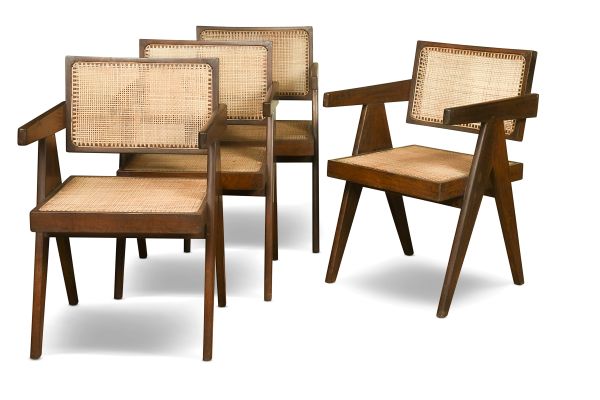Pierre Jeanneret, a Swiss-French architect and designer, played a pivotal role in shaping the modernist identity of Chandigarh, India’s first planned city after independence. Together with his cousin, Le Corbusier, the pair laid out a vision for the infrastructure of the city, and designed furniture to match. This seminal project would go on to be one of the most important in design and architecture of the time, with appetites now for Jeanneret’s Chandigarh pieces reaching new heights at auction, and there is a significant collection of these available as part of The Art & Design Sale on 27th February.

Lot 246, Pierre Jeanneret (1896-1967) for Chandigarh, a set of four caned teak PJ-010100T chairs, known as 'Office cane chairs' or 'Secretariat Chairs', painted 'PU' in Punjab for Punjabi University, estimate £4,000 - £6,000
The city of Chandigarh was conceived as a symbol of India’s aspirations in the wake of independence in 1947. Prime Minister Jawaharlal Nehru envisioned a modern, planned city for Punjab to reflect the country’s commitment to progress and growth. While Le Corbusier drafted the city’s master plan, Jeanneret stayed on-site for over fifteen years, overseeing the design and construction of its buildings, residences, and furniture. His approach combined modernist ideals with local materials and techniques, ensuring that the city’s architecture was both practical and in harmony with its environment.
Jeanneret’s visual language was characterised by simplicity, clean lines, and functionality. His architectural designs often featured sloping roofs, open layouts, and perforated concrete screens, which provided natural ventilation and light in Chandigarh’s warm climate. He also used local materials like teak and rattan, as seen in the furniture available at the Art & Design Sale, blending modern design principles with regional traditions. His most iconic contribution was the Chandigarh Chair, designed for government offices and educational institutions. With its distinctive V-shaped legs, angular frame, and woven cane seat, the chair exemplified his commitment to creating furniture that was both practical and aesthetically refined.

Lot 240, Pierre Jeanneret (1896-1967) for Chandigarh, a pair of caned teak 'Easy' armchairs, circa 1955, estimate £3,000 - £5,000.
Although Jeanneret’s designs were utilitarian in their time, they have since gained global recognition. The Chandigarh Chair, once a common feature of institutional spaces, is now a highly coveted collector’s item, prized for its timeless elegance and craftsmanship. Due to the wear and tear that these pieces saw in the government and public buildings in Chandigarh, true original pieces can be hard to come by, as reported by The World of Interiors in in 2024, “Hard use in public buildings, such as the university and college, led to elements such as woven cane and canvas wearing out quickly. Rather than restore the furniture, which in any case was deemed fairly plentiful, chairs and tables were discarded.” This rarity has helped to push up prices, with the best in class of Chandigarh pieces now able to achieve six-figure sums at auction.
The collection available at the Art & Design Sale on 27th February has been consigned from a private collection, acquired in India in the 1980s, and includes a comprehensive series of original Chandigarh pieces, including a set of four caned teak chairs which were created for Chandigarh Library, which have an estimate of £2,000 - £4,000, a series of four chairs known as ‘Office cane chairs’ which were made for Punjabi University which have an estimate of £4,000 and £6,000 and a series of stools, benches and coffee tables.
To view the Chandigarh pieces available, please click here